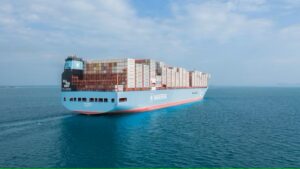
As 2024 comes to a close, we reflect on a year of challenges and progress across global supply chains. This month’s update highlights key market trends, including progress in the fight against inflation and signs of resilience in major economies. We also explore logistics preparations for year-end peak seasons, emphasizing the importance of agility and proactive planning. From innovative solutions in ocean and air freight to the continued evolution of Maersk’s inland and logistics services, we remain committed to helping our customers navigate an ever-changing landscape in global supply chain.
This month, we introduce a new spotlight column on key markets in Asia Pacific, starting with Southeast Asia. We’re looking forward to ringing in the New Year and kicking off a strong 2025 together with you!
Market Trends
The global fight against inflation has made significant progress, with price pressures easing in most regions, though challenges persist in some countries. After peaking at 9.4% year-on-year in Q3 2022, headline inflation is expected to decline to 3.5% by the end of 2025, slightly below the pre-pandemic average of 3.6% recorded between 2000 and 2019. (IMF World Economic Outlook, October 2024).
In the U.S. the growth forecast for 2024 is expected to be 2.8%. This reflects stronger-than-expected performance in consumption and nonresidential investment. The resilience in consumer spending is primarily driven by significant real wage growth, particularly among lower-income households, and the positive impact of wealth effects.
In the Euro area GDP growth for 2024 is expected to reach a modest 0.8%, driven by improved export performance, particularly in goods, and improved retail sales, which grew 2.6% y/y in October (Maersk Strategic Insights). Rising real wages are projected to boost consumption, while a gradual easing of monetary policy is expected to encourage investment. However, persistent challenges in manufacturing continue to weigh on growth, particularly for Germany and Italy (IMF World Economic Outlook, October 2024).
China’s economic slowdown is anticipated to unfold at a more measured pace, with growth in 2024 forecast to decline only slightly to 4.8%. While challenges persist, including weakness in the real estate sector and dampened consumer confidence. This resilience is largely attributed to stronger-than-expected gains in net exports, which have helped offset domestic headwinds (IMF World Economic Outlook, October 2024). China is currently the only large economy with a manufacturing PMI above 50 (Maersk Strategic Insights).
Trending Topic – Strengthening Logistics Resilience for 2025
Resilience in logistics is not just about reacting to disruptions; it’s about planning smarter and anticipating challenges. From port congestion caused by the Red Sea to drought-driven delays at the Panama Canal and labor unrest in the U.S., these events have underscored the critical need for greater predictability and reliability in global supply chains.
As businesses prepare for 2025, companies should consider a number of strategies, which might include diversifying suppliers and inventory control – where do you put your stock and how much? That might include nearshoring or nearsourcing depending on your industry. Segmenting the supply chain is another important strategy – don’t rely on a single route but map out alternatives and consider multi-modal transportation.
Balancing resilience with cost-effectiveness is also a major consideration. Having a solid plan in place can enable you to not only meet customers’ expectations, but to even build an advantage in the market by being able to react faster than your competitors. In that respect it could be considered a long-term investment.
A cornerstone of this transformation to resilient supply chains is the Network of the Future, a modular hub-and-spoke model designed to streamline operations and minimize risks at traditional chokepoints. By reducing port calls and leveraging dedicated shuttles and advanced hubs, the Network will help ensure smoother and more predictable supply chains, with the aim to achieve over 90% schedule reliability.
With increasing volatility in the markets, Maersk is also introducing updates to contracting models to make them more resilient to volatility. For customers, this means guaranteed, market-relevant rates, providing peace of mind.
